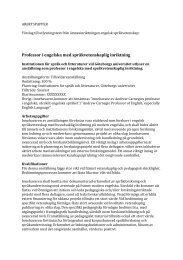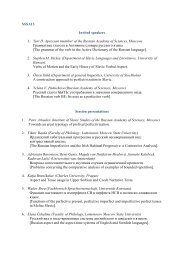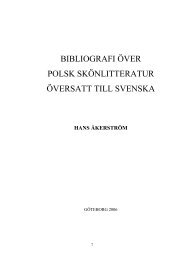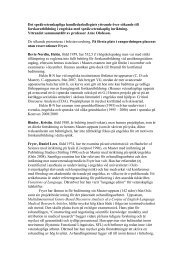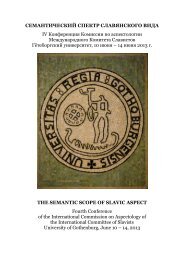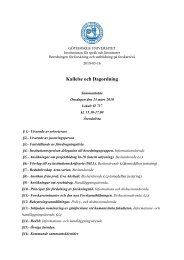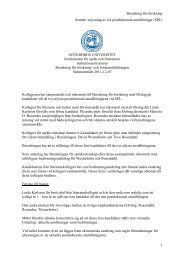Style Sheet for Literary Essays Written for English at SPL
Style Sheet for Literary Essays Written for English at SPL
Style Sheet for Literary Essays Written for English at SPL
You also want an ePaper? Increase the reach of your titles
YUMPU automatically turns print PDFs into web optimized ePapers that Google loves.
ENGLISH<br />
Version 1.0: 130314<br />
<strong>Style</strong> <strong>Sheet</strong> <strong>for</strong> <strong>Literary</strong> <strong>Essays</strong> <strong>Written</strong><br />
<strong>for</strong> <strong>English</strong> <strong>at</strong> <strong>SPL</strong><br />
Some Common Referencing and Form<strong>at</strong>ting Situ<strong>at</strong>ions<br />
Joe Trotta och Chloé Avril<br />
(not a) BA/MA/ thesis<br />
Supervisor:<br />
Homer Simpson<br />
Examiner:<br />
Marge Simpson
Title: <strong>Style</strong> <strong>Sheet</strong> <strong>for</strong> <strong>Literary</strong> <strong>Essays</strong> <strong>Written</strong> <strong>for</strong> <strong>English</strong> <strong>at</strong> <strong>SPL</strong>: Some Common Referencing<br />
and Form<strong>at</strong>ting Situ<strong>at</strong>ions<br />
Author: Joe Trotta and Chloé Avril<br />
Supervisor: Homer Simpson<br />
Abstract: The aim of this text is to present the most common referencing and <strong>for</strong>m<strong>at</strong>ting<br />
situ<strong>at</strong>ions <strong>for</strong> students when writing an academic essay in <strong>English</strong> liter<strong>at</strong>ure <strong>at</strong> the Department of<br />
Languages and Liter<strong>at</strong>ures, University of Gothenburg. It illustr<strong>at</strong>es many standard <strong>for</strong>m<strong>at</strong>ting<br />
issues <strong>for</strong> both in-text cit<strong>at</strong>ions and bibliographical references based on the MLA style. The<br />
primary m<strong>at</strong>erials used here were references to diverse sources, both in print and online; the<br />
method (as far as there was one) was a qualit<strong>at</strong>ive analysis of the g<strong>at</strong>hered m<strong>at</strong>erial followed by a<br />
selection of the most represent<strong>at</strong>ive situ<strong>at</strong>ions. This is not an academic research paper, so there is<br />
no scholarly conclusion drawn, but this paper clearly illustr<strong>at</strong>es th<strong>at</strong> cit<strong>at</strong>ions and references are<br />
by no means a simple m<strong>at</strong>ter and th<strong>at</strong> much care must be given in order to follow the appropri<strong>at</strong>e<br />
<strong>for</strong>m<strong>at</strong>ting guidelines.<br />
Keywords: <strong>Style</strong> sheet, <strong>for</strong>m<strong>at</strong>ting, reference, MLA, footnote, quote, in-text cit<strong>at</strong>ion, primary<br />
m<strong>at</strong>erial, secondary m<strong>at</strong>erial, print sources, non-print sources
Table of Contents<br />
1. Introduction .................................................................................................................................. 1<br />
2. Preliminaries ................................................................................................................................. 1<br />
Basic Fe<strong>at</strong>ures .............................................................................................................................. 1<br />
Title Page ...................................................................................................................................... 2<br />
The Abstract ................................................................................................................................. 2<br />
Table of Contents ......................................................................................................................... 3<br />
3. Fe<strong>at</strong>ures of the Actual Paper ........................................................................................................ 3<br />
Paragraphing ................................................................................................................................. 3<br />
Sectioning ..................................................................................................................................... 3<br />
Cit<strong>at</strong>ions and Quot<strong>at</strong>ions .............................................................................................................. 4<br />
Footnotes ...................................................................................................................................... 5<br />
Punctu<strong>at</strong>ion, Font Conventions, Abbrevi<strong>at</strong>ions ............................................................................ 6<br />
Plagiarism ..................................................................................................................................... 7<br />
4. Form<strong>at</strong> of References in the Bibliography ................................................................................... 7<br />
Books ............................................................................................................................................ 7<br />
Articles ......................................................................................................................................... 9<br />
Articles in Journals (Including Reviews) ................................................................................. 9<br />
Articles/Chapters in Books ..................................................................................................... 10<br />
Articles in Newspapers and Non-scholarly Sources .............................................................. 11<br />
The World Wide Web (WWW) ................................................................................................. 11<br />
Citing Online Dictionaries and Reference Works such as Wikipedia ........................................ 12<br />
Other Common Sources ............................................................................................................. 12<br />
Interviews ............................................................................................................................... 12<br />
Motion Pictures and TV Series/Episodes ............................................................................... 13<br />
Sound Recordings .................................................................................................................. 13<br />
5. Conclusion .................................................................................................................................. 14<br />
Bibliography ................................................................................................................................... 15
1. Introduction<br />
The purpose of this guide is to give you clear instructions on how to lay out a paper written as<br />
part of a liter<strong>at</strong>ure course in this department. It will in<strong>for</strong>m you about the <strong>for</strong>mal requirements of<br />
such a paper, especially with regard to sections, quot<strong>at</strong>ions, and references. For your<br />
convenience, the <strong>for</strong>m<strong>at</strong> adopted <strong>for</strong> this guide reflects the one required <strong>for</strong> your paper (cf., <strong>for</strong><br />
example, paragraph indent<strong>at</strong>ion style, the <strong>for</strong>m<strong>at</strong> of the headings, text, footnotes, 1 in-text<br />
cit<strong>at</strong>ions, references, etc.).<br />
Apart from the <strong>for</strong>mal criteria, there are a number of additional aspects of academic writing<br />
you should consider when writing papers in liter<strong>at</strong>ure. You should try to write in a readable and<br />
accessible style, and make sure th<strong>at</strong> your arguments are expressed coherently and concisely.<br />
Additional in<strong>for</strong>m<strong>at</strong>ion on various aspects of academic writing is available in several books in the<br />
library and also <strong>for</strong> example on the following websites: www.uefap.co.uk (see also “Links”<br />
section), http://owl.english.purdue.edu/.<br />
2. Preliminaries<br />
Basic Fe<strong>at</strong>ures<br />
You should use A4 paper and print on one side only. Set all margins of your document (left,<br />
right, top and bottom) <strong>at</strong> 2.5 cm. To make the paper easier to read, use a line spacing of 1.5 (as<br />
used in this text). However, footnotes, long quot<strong>at</strong>ions, the abstract and the references should be<br />
single-spaced. The main body of the text should be left justified (or fully justified). Choose the<br />
Times New Roman font (the font used here), size 12 (<strong>for</strong> the body text). Finally, all pages<br />
should be consecutively numbered, beginning with the page which carries the introduction (i.e.<br />
not counting the title page, the abstract page or the table of contents page). The sections of the<br />
paper should be arranged in the following order: title page, abstract, table of contents, main<br />
text, references, appendix (if applicable).<br />
1 This is roughly wh<strong>at</strong> your footnote should look like. In most cases, your word processing program will take care of<br />
all the details, if not then keep in mind th<strong>at</strong> footnotes should be Times New Roman, font size 10 and the line spacing<br />
should be single-spaced.<br />
1
Your paper may follow British or American <strong>English</strong> spelling and grammar conventions.<br />
However, once you have made your choice, be consistent. If your word-processor has a<br />
spellchecker, set it <strong>for</strong> either British or American <strong>English</strong>, and use it. If you use a word-processor,<br />
there should be no need <strong>for</strong> corrections by hand. If you do discover any errors after printing,<br />
correct them ne<strong>at</strong>ly in ink.<br />
The length of your paper will normally be prescribed by the type of essay you are writing<br />
(e.g. a bachelor’s degree essay will be ca. 8000 words, an interdisciplinary paper will be 8000 to<br />
10,000 words, and so on). Use the word-count on your computer to check th<strong>at</strong> your paper is<br />
neither too long nor too short, and th<strong>at</strong> the various sections are of appropri<strong>at</strong>e lengths.<br />
Title Page<br />
For the title page, please use one of the ready-made templ<strong>at</strong>es. If you are unsure which templ<strong>at</strong>e<br />
to use, contact your supervisor.<br />
The Abstract<br />
The example below serves as an illustr<strong>at</strong>ion of how you can organize and <strong>for</strong>m<strong>at</strong> your abstract.<br />
This is the in<strong>for</strong>m<strong>at</strong>ion you need to include in an abstract: the title of the essay, the author’s<br />
name, supervisor’s name, the actual abstract (which should mention aims, method/m<strong>at</strong>erial<br />
and main results) and finally keywords (<strong>at</strong> least 5, no more than 10).<br />
Abstract example<br />
Title: The Poetry of Idries Davies and Postcolonial Wales<br />
Author: Jane Smith<br />
Supervisor: Marge Simpson<br />
Abstract: In recent years there has been a deb<strong>at</strong>e about whether or not Wales can be seen as a<br />
postcolonial society. This essay is a contribution to this ongoing discussion through its focus on<br />
the poetry of Idries Davies, one of Wales’s most important modern poets. By applying the<br />
postcolonial concepts of exile, migr<strong>at</strong>ion, margin and centre to a selection of Davies’s poetry, the<br />
essay shows th<strong>at</strong> Davies’s writing has much to say about the colonial and postcolonial experience<br />
of ordinary Welsh people. The focus of the argument is both on the postcolonial condition th<strong>at</strong><br />
Davies explores in his writing, as well as the poetic voice he gives to the Welsh characters he<br />
portrays in his three epic poems, Gwalia Deserta (1938), The Angry Summer (1943) and<br />
Tonypandy (1945).<br />
Keywords: Idries Davies, Gwalia Deserta, The Angry Summer, Tonypandy, Wales,<br />
postcolonialism, exile, migr<strong>at</strong>ion, margin, centre<br />
2
Table of Contents<br />
This page should carry the title ‘Table of contents’ <strong>at</strong> the top. Leave a few lines and then begin to<br />
list the contents: section titles on the left, the pages on which the sections begin on the right (see<br />
the Table of Contents page of this guide <strong>for</strong> an example). Most modern word processing<br />
programs will do this autom<strong>at</strong>ically if you insert the headings properly using the correct heading<br />
level from the preset ones from the top ribbon in the program (e.g., in Word 2010, this is a series<br />
of different styles to the right-hand of the page). Please note th<strong>at</strong> the references and any<br />
appendices should also be included in the table of contents.<br />
3. Fe<strong>at</strong>ures of the Actual Paper<br />
Paragraphing<br />
Make sure th<strong>at</strong> you follow the two important rules of academic writing: unity and coherence.<br />
Unity can be best explained by the expression ‘one idea, one paragraph’, meaning th<strong>at</strong> you need<br />
to focus on one argument <strong>at</strong> a time and indic<strong>at</strong>e the transition to a new argument (or subargument)<br />
by beginning a new paragraph. However, avoid very short paragraphs, especially those<br />
containing only one sentence. Coherence refers to the fact th<strong>at</strong> your essay should be organized in<br />
a logical manner and th<strong>at</strong> links within and between paragraphs should be made explicit.<br />
Each new paragraph should be ‘indented’ which means th<strong>at</strong> the first line should start further<br />
right than the following lines (usually about 1 cm from the margin). Note th<strong>at</strong> paragraphs<br />
beginning new sections or following quot<strong>at</strong>ions are NOT indented.<br />
Sectioning<br />
To help organize your work, it is worth dividing it up into explicitly marked chapters or sections.<br />
This helps to make it obvious <strong>for</strong> the reader wh<strong>at</strong> you are dealing with <strong>at</strong> any moment in time and<br />
gives a very clear overall structure to your work. In literary essays it is common to have between<br />
4 and 5 sections/chapters, including the introduction and conclusion. Remember th<strong>at</strong> all the<br />
different sections of your essay should be clearly rel<strong>at</strong>ed to your main thesis. You need to<br />
indic<strong>at</strong>e the focus of each section/chapter by a heading. In titles and headings, the first letter of<br />
each main word should be capitalized. The same applies to the table of contents. For an example<br />
of sectioning, look closely <strong>at</strong> this guide. It has been set out according to the above principles.<br />
3
Cit<strong>at</strong>ions and Quot<strong>at</strong>ions<br />
In the text, the details of the liter<strong>at</strong>ure referred to are not indic<strong>at</strong>ed in full and are not indic<strong>at</strong>ed in<br />
a footnote. Instead, two pieces of in<strong>for</strong>m<strong>at</strong>ion are given in brackets after the relevant passage:<br />
(Author’s surname and Relevant page/s), <strong>for</strong> example (Felski 9). If an author’s name is part of<br />
the running text, integr<strong>at</strong>e it in a suitable way, <strong>for</strong> instance “Felski explains th<strong>at</strong> the concept of…”<br />
(9) or “According to Felski, the concept …” (9).<br />
Cit<strong>at</strong>ions of books or articles by more than one author take the <strong>for</strong>m (Gilbert and Gubar<br />
215), (Ashcroft, Griffiths, and Tiffin 11). If a text has more than three authors, provide the name<br />
of the first author followed by et al., as in (Smith et al.). When a cit<strong>at</strong>ion refers to a work<br />
consisting of more than one volume, you should indic<strong>at</strong>e both the volume number and the page<br />
number as in: (1: 235). When citing works by several authors with the same last name use initials<br />
to differenti<strong>at</strong>e them, <strong>for</strong> example (V. Woolf 146-48) and (L. Woolf 12).<br />
When citing internet sources, include in the text or within parenthesis the first element th<strong>at</strong><br />
will appear in your bibliography. This can be the author’s name, the title of the article or the<br />
name of the website. Indic<strong>at</strong>e page numbers whenever possible. It is helpful to insert the word<br />
online in the text to help the reader understand why some in<strong>for</strong>m<strong>at</strong>ion th<strong>at</strong> would usually be<br />
mand<strong>at</strong>ory (such as an author’s name and a page number) is missing from your cit<strong>at</strong>ion.<br />
Try to avoid citing titles indirectly via another source containing this cit<strong>at</strong>ion. If required,<br />
these cit<strong>at</strong>ions take the <strong>for</strong>m (Carby qtd. in Suleri 277). Only the text you actually consulted<br />
should appear in the bibliography.<br />
Indirect quot<strong>at</strong>ions or paraphrases present the ideas or arguments of an author in your own<br />
words. In this case, it is important th<strong>at</strong> you add the source from which you gained the respective<br />
in<strong>for</strong>m<strong>at</strong>ion in brackets. An example of paraphrase is:<br />
The writing of Virginia Woolf is particularly fitted to a contextual approach since she herself was<br />
well aware of the link between literary production and an author’s social and personal<br />
situ<strong>at</strong>edness (Shaw 156).<br />
Verb<strong>at</strong>im (i.e. word-<strong>for</strong>-word) quot<strong>at</strong>ions can be integr<strong>at</strong>ed in two basic <strong>for</strong>m<strong>at</strong>s: if the<br />
quote is quite short (less than approx. 50 words/3 lines), it is included in the main body of the text<br />
and enclosed within double quot<strong>at</strong>ion marks, as in the following example:<br />
4
In an article on Mrs Dalloway and A Room of One’s Own, Marion Shaw claims th<strong>at</strong> Woolf “was<br />
one of the first writers to consider seriously and <strong>at</strong> length the rel<strong>at</strong>ionship between an author’s<br />
historical and personal situ<strong>at</strong>ion and his or her work” (156).<br />
If the quote is longer, it is presented as a separ<strong>at</strong>e paragraph, with each line indented about 2 cm<br />
from the left margin; the line spacing <strong>for</strong> the quote is single, the font size is reduced to 10 and the<br />
quote is not enclosed in quot<strong>at</strong>ion marks:<br />
In her award-winning book Radical Children’s Liter<strong>at</strong>ure (2007), Kimberley Reynolds argues<br />
th<strong>at</strong> while contemporary children’s liter<strong>at</strong>ure certainly explores new problem areas, children have<br />
in fact always been confronted with less than optimistic narr<strong>at</strong>ives:<br />
Despite ef<strong>for</strong>ts to protect children from books and other kinds of reading th<strong>at</strong> could leave them feeling<br />
hopeless, the young have always encountered frightening, nihilistic, and depressive ‘stories’ in a<br />
variety of contexts – from the news through popular soap operas and even such ‘family favourite’<br />
films as Walt Disney’s version of Bambi. (89)<br />
All direct quot<strong>at</strong>ions should follow the original text exactly – in wording, spelling and<br />
punctu<strong>at</strong>ion. Any additions or changes th<strong>at</strong> you make should be indic<strong>at</strong>ed by square brackets [ ].<br />
In the example below in is, contrary to the original text, spelt with a lowercase i:<br />
According to Collie and Sl<strong>at</strong>er, “[i]n order <strong>for</strong> us to justify the additional time and ef<strong>for</strong>t which<br />
will undoubtedly be needed <strong>for</strong> learners to come to grips with a work of liter<strong>at</strong>ure in a language<br />
not their own, there must be some special incentive involved” (6).<br />
If you omit part of a quot<strong>at</strong>ion, indic<strong>at</strong>e this by ellipsis points in square brackets: […]. For<br />
example: “Since the end of the twentieth century, children’s liter<strong>at</strong>ure has reflected many of the<br />
themes […] identified by Showalter” (Reynolds 151). If you should spot mistakes (e.g. typos) in<br />
the original text, you may add L<strong>at</strong>in [sic] in square brackets after the flawed construction in<br />
question. If you use quot<strong>at</strong>ions from languages other than <strong>English</strong> in the text, give the quote in<br />
the original language first and enclose the transl<strong>at</strong>ion in square brackets.<br />
Footnotes<br />
Footnotes are not used to indic<strong>at</strong>e the source of cit<strong>at</strong>ions (these are included in the running text –<br />
see section above). Use footnotes only when referring to further discussions of a topic or to<br />
include extra in<strong>for</strong>m<strong>at</strong>ion. Number them consecutively throughout the text, and make sure th<strong>at</strong> all<br />
punctu<strong>at</strong>ion marks as well as closing parentheses precede note numbers in the text.<br />
5
Punctu<strong>at</strong>ion, Font Conventions, Abbrevi<strong>at</strong>ions<br />
Conventions on the use of quot<strong>at</strong>ion marks can vary considerably, but we recommend th<strong>at</strong> you<br />
use “double quot<strong>at</strong>ion marks” <strong>for</strong> direct quot<strong>at</strong>ions; use ‘single quot<strong>at</strong>ion’ marks <strong>for</strong> glosses,<br />
definitions, ‘qualified’ words or phrases, or <strong>for</strong> quot<strong>at</strong>ions within quot<strong>at</strong>ions. Quot<strong>at</strong>ion marks go<br />
inside punctu<strong>at</strong>ion when only part of a sentence or the title of an article/a contribution to a book<br />
is quoted; unless the punctu<strong>at</strong>ion mark is part of the quot<strong>at</strong>ion:<br />
The Swedish word gymnasium means ‘upper secondary school’, not ‘gymnasium’.<br />
In her article “Problems of Gender and History in the teaching of Things Fall Apart”, Rhonda<br />
Cobham suggests th<strong>at</strong>…<br />
Consequently, the text type drama has been described as “a stereotypically ‘oral’ register” (Biber<br />
& Finegan 1997: 260).<br />
This is the way he used the question “Wh<strong>at</strong>’s up bro”.<br />
Use italics if you cite a word, phrase, or sentence as a concept or as the object of discussion; do<br />
not use quot<strong>at</strong>ion marks <strong>for</strong> this purpose. If you want to indic<strong>at</strong>e emphasis, do this by using<br />
language wherever possible, r<strong>at</strong>her than typographic fe<strong>at</strong>ures. If it has to be done typographically,<br />
please do not use italics but bold type.<br />
Avoid using too many abbrevi<strong>at</strong>ions; they often pose severe problems <strong>for</strong> readers not<br />
completely familiar with the language of a text. Where more than one abbrevi<strong>at</strong>ion is acceptable,<br />
select one and use it consistently throughout the text. Abbrevi<strong>at</strong>ions ending in a small letter have<br />
a full stop following them (e.g. OFr., Gk., L<strong>at</strong>.), those ending in a capital letter do not (e.g. MHG,<br />
OCS, OE). Here are some abbrevi<strong>at</strong>ions which are frequently used:<br />
cf. (confer, ‘compare’) Usually used in footnotes to indic<strong>at</strong>e a source th<strong>at</strong> develops an<br />
argument you make: cf. Spivak <strong>for</strong> a detailed discussion of the concept of the subaltern.<br />
e.g. (exempli gr<strong>at</strong>ia, ‘<strong>for</strong> example’) Any section can have sub-sections (e.g. 1.1.).<br />
i.e. (id est, ‘in other words’) Begin your list of references on a new page (i.e. the one after your<br />
conclusion).<br />
[sic] (not an abbrevi<strong>at</strong>ion - means something like ‘as it is written’) … his l<strong>at</strong>est school job page<br />
advertises “a wide rnage [sic] of 6th <strong>for</strong>m courses”.<br />
6
Plagiarism<br />
Plagiarism (i.e. using another person’s ideas or phrasing, and representing them as your own<br />
without acknowledging it) is a serious offence. Please respect and obey the academic code of<br />
conduct (see also the Gothenburg university guidelines available online <strong>at</strong> the following address:<br />
http://www.ub.gu.se/skriva/plagiering/ or consult the rules and regul<strong>at</strong>ions in<strong>for</strong>m<strong>at</strong>ion <strong>for</strong><br />
students <strong>at</strong> http://www.rk.gu.se/digitalAssets/1299/1299480_regelsamling_svensk.pdf). If you are<br />
ever in doubt, please contact your supervisor/teacher.<br />
4. Form<strong>at</strong> of References in the Bibliography<br />
The references <strong>at</strong> the end of the manuscript give full cit<strong>at</strong>ion details of the liter<strong>at</strong>ure referred to in<br />
the text. Make sure th<strong>at</strong> your bibliography comprises all of the books/articles/etc. referred to in<br />
the running text of your paper and vice versa! Always begin your bibliography on a new page<br />
(i.e. the one directly after your conclusion). The references are always ordered alphabetically and<br />
chronologically if there is more than one work by the same author. First names should be written<br />
out in full, i.e. try to avoid initials if th<strong>at</strong> is possible. If a reference stretches over more than one<br />
line, the second line should be indented (a so-called ‘hanging’ indent<strong>at</strong>ion) as in the examples<br />
given below as well as in the bibliography. We recommend th<strong>at</strong> you use the same spacing in the<br />
bibliography as <strong>for</strong> the rest of the document, i.e. 1.5 spacing.<br />
Books<br />
You must give six pieces of in<strong>for</strong>m<strong>at</strong>ion: 1) Author/Editor, 2) Title, 3) Place of public<strong>at</strong>ion, 4)<br />
Publisher, 5) Year of public<strong>at</strong>ion, and 6) Medium. The author’s/editor’s surname is always the<br />
first piece of in<strong>for</strong>m<strong>at</strong>ion and is followed by the author’s/editor’s first name. Next comes the title<br />
of the work which should be italicized. Note th<strong>at</strong> titles in languages other than <strong>English</strong> should be<br />
transl<strong>at</strong>ed into the language of the text with the transl<strong>at</strong>ion following the original title in square<br />
brackets. In<strong>for</strong>m<strong>at</strong>ion about the edition used may be given after the title. After th<strong>at</strong> comes the<br />
place of public<strong>at</strong>ion followed by the name of the publisher. The year of public<strong>at</strong>ion is indic<strong>at</strong>ed<br />
(if a work has not yet been published, add ‘in press’ or ‘<strong>for</strong>thcoming’). Finally, add the medium<br />
of the work – most commonly <strong>for</strong> books ‘Print’.<br />
Author’s/Editor’s surname, Author’s/Editor’s first name, ed. [if applicable]. Title. Edition<br />
[if applicable]. Place of public<strong>at</strong>ion: Publisher, Year. Medium.<br />
7
Reynolds, Kimberley. Radical Children’s Liter<strong>at</strong>ure: Future Visions and Aesthetic<br />
Trans<strong>for</strong>m<strong>at</strong>ions in Juvenile Fiction. Basingstoke: Palgrave Macmillan, 2007. Print.<br />
Marable, Manning. Race, Re<strong>for</strong>m and Rebellion: The Second Reconstruction and Beyond in<br />
Black America, 1945-2006. 3rd ed. Jackson: University Press of Mississippi, 2007. Print.<br />
Halpern, Daniel, ed. The Art of the Story: An Intern<strong>at</strong>ional Anthology of Contemporary Short<br />
Stories. London: Penguin, 2000. Print.<br />
Eduards, Maud. Kroppspolitik: Om Moder Svea och Andra Kvinnor [Body Politics: On Mother<br />
Svea and Other Women]. Stockholm: Atlas, 2007. Print.<br />
If there is more than one author/editor, use the order given on the book, which may or may not be<br />
alphabetical, and separ<strong>at</strong>e them by a comma. Note th<strong>at</strong> the order in which you give the first<br />
author’s surname and first name is inverted <strong>for</strong> all following authors. Add ‘and’ be<strong>for</strong>e the name<br />
of the last author:<br />
Author’s surname, Author’s first name[, and 2nd author’s first name 2nd author’s surname].<br />
Title. edition [if applicable]. Place of public<strong>at</strong>ion: Publisher, Year. Medium.<br />
Collie, Joanne, and Stephen Sl<strong>at</strong>er. Liter<strong>at</strong>ure in the Language Classroom: A Resource Book of<br />
Ideas and Activities. New Delhi: Cambridge University Press, 2009. Print.<br />
Ashcroft, Bill, Gareth Griffiths, and Helen Tiffin, eds. The Post-colonial Studies Reader.<br />
London: Routledge, 1997. Print.<br />
Rooney, Caroline and Rita Sakr, eds. The Ethics of Represent<strong>at</strong>ion in Liter<strong>at</strong>ure, Art and<br />
Journalism. New York: Routledge, Forthcoming. Print.<br />
Irwin, William, Mark T. Conard, and Aeon J. Skoble, eds. The Simpsons 2 and Philosophy: The<br />
D’oh of Homer. Peru, Ill.: Open Court Publishing.<br />
If a work has more than three authors, only name the first author followed by et al.:<br />
Baym, Nina, et al. The Norton Anthology of American Liter<strong>at</strong>ure: Vol. 1. New York: W.W.<br />
Norton & Co, 1998. Print.<br />
2 Note th<strong>at</strong> titles within titles (such as The Simpsons in this case) are not italicized.<br />
8
It may sometimes be important to signal th<strong>at</strong> the d<strong>at</strong>e of public<strong>at</strong>ion of a work which you have<br />
consulted does not correspond to when the text was originally published. In this case you need to<br />
give first the original d<strong>at</strong>e of public<strong>at</strong>ion after the title and then the d<strong>at</strong>e of public<strong>at</strong>ion of your<br />
edition in the usual manner, after the name of the publisher:<br />
Butler, Judith. Gender Trouble. 1990. New York: Routledge, 1999. Print.<br />
PhD, MA and BA theses are referred to as follows:<br />
Johnson G<strong>at</strong>zouras, Vicky. “Family M<strong>at</strong>ters in Greek American Liter<strong>at</strong>ure.” Diss. Blekinge<br />
Tekniska Högskolan, 2007. Print.<br />
Sandahl, Ann-Louise. “Posthumanistiska Subjekt i Visuell Kultur [Posthumanist Subjects in<br />
Visual Culture].” MA thesis. University of Gothenburg, 2012. Print.<br />
Bäckström, Linn. “‘An Identity of One’s Own’: A Discussion of Gender and Sexuality in<br />
Jeanette Winterson’s <strong>Written</strong> on the Body.” BA thesis. Lund University, 2011. Print.<br />
Special cases can include a transl<strong>at</strong>ed book or a book prepared by an editor:<br />
Foucault, Michel. Madness and Civiliz<strong>at</strong>ion: A History of Insanity in the Age of Reason. Trans.<br />
Richard Howard. New York: Vintage-Random House, 1988. Print.<br />
Achebe, Chinua. Things Fall Apart. Ed. Francis Abiola Irele. New York: W.W. Norton & Co,<br />
2009. Print.<br />
Articles<br />
Articles in Journals (Including Reviews)<br />
List the following in<strong>for</strong>m<strong>at</strong>ion in the following order:<br />
Author’s surname, author’s first name[, and 2nd author’s first name 2nd author’s surname].<br />
“Title of article.” Title of Journal/Periodical Volume.Issue (Year): pages. Medium of<br />
public<strong>at</strong>ion.<br />
For example:<br />
McElroy, Ruth. “Whose Body, Whose N<strong>at</strong>ion: Surrog<strong>at</strong>e Motherhood and its Represent<strong>at</strong>ion.”<br />
European Journal of Cultural Studies 5.3 (2002): 325-42. Print.<br />
When referencing an article which you have consulted online, write ‘Web’ <strong>for</strong> the medium of<br />
public<strong>at</strong>ion followed by the d<strong>at</strong>e of access:<br />
9
Hsiao, Irene, C. “Broken Chord: Sounding Out the Ideogram in Marilyn Chin’s Rhapsody in<br />
Plain Yellows.” MELUS: Multi-Ethnic Liter<strong>at</strong>ure of the U.S. 37.3 (2012): 189-214. Web.<br />
17 Jan. 2012.<br />
When citing sources you have accessed via online d<strong>at</strong>abases such as EBSCO, Academic Search<br />
Elite, JSTOR, Project Muse, ProQuest, Science Online, etc., you need to indic<strong>at</strong>e this in the<br />
following way:<br />
Lasser, Michael L. “Shakespeare: Finding and Teaching the Comic Vision.” <strong>English</strong> Record 20.2<br />
(1969): 4-17. ProQuest. Web. 17 Dec. 2010.<br />
Reviews are cited in the following way (note th<strong>at</strong> the first review has a title of its own, while the<br />
second doesn’t):<br />
Shea, Renee H. “The Urgency of Knowing.” Rev. of Buddah in the Attic, by Julie Otsuka. Poets<br />
& Writers Sep/Oct 2011: 50-56. Academic Search Elite. Web. 24 Jan. 2012.<br />
Leiding, Reba. Rev. of When The Emperor Was Divine, by Julie Otsuka. Library Journal 127.14<br />
(2002): 215. Academic Search Elite. Web. 19 Jan. 2013.<br />
Articles/Chapters in Books<br />
List the following in<strong>for</strong>m<strong>at</strong>ion in the following manner:<br />
Author’s surname, author’s first name[, and 2nd author’s first name 2nd author’s surname].<br />
“Title of Chapter.” Title of Book. Ed(s). Editor’s name(s). City of Public<strong>at</strong>ion:<br />
Publisher, Year. Page range of chapter. Medium of Public<strong>at</strong>ion.<br />
For example:<br />
Ali, Saba Rasheed, and Julie R. Ancis. “Multicultural Educ<strong>at</strong>ion and Critical Pedagogy<br />
Approaches.” Teaching and Social Justice: Integr<strong>at</strong>ing Multicultural and Feminist<br />
Theories in the Classroom. Eds. Carolyn Zerbe Enns and Ada L. Sinacore. Washington,<br />
DC: American Psychological Associ<strong>at</strong>ion, 2005. 69-84. Print.<br />
Dantic<strong>at</strong>, Edwidge. “Night Women.” The Art of the Story: An Intern<strong>at</strong>ional Anthology of<br />
Contemporary Short Stories. Ed. Daniel Halpern. London: Penguin, 2000. 196-98. Print.<br />
De Luca, Vincent Arthur. “Blake’s Concept of the Sublime.” Romanticism: A Critical Reader.<br />
Ed. Duncan Wu. 17-54. Print.<br />
10
Articles in Newspapers and Non-scholarly Sources<br />
List the following in<strong>for</strong>m<strong>at</strong>ion in the following manner:<br />
Author’s surname, author’s first name[, and 2nd author’s first name 2nd author’s surname].<br />
“Title.” Newspaper/Magazine Day Month Year: Page(s). Medium of public<strong>at</strong>ion.<br />
For electronic sources, always add ‘Web’ followed by the d<strong>at</strong>e of access.<br />
Faludi, Susan. “American Electra: Feminism’s Ritual M<strong>at</strong>ricide.” Harpers October 2010: 29-42.<br />
Web. 14 May 2011.<br />
Day, Elizabeth. “In the Grip of a Tale: Storytelling Sessions Prove the Oral Tradition is Back in<br />
Fashion.” The Observer 6 Jan. 2013: 24. Print.<br />
The World Wide Web (WWW)<br />
For obvious reasons, you should tre<strong>at</strong> in<strong>for</strong>m<strong>at</strong>ion from the internet with caution. To cite files<br />
available on the WWW, follow the basic <strong>for</strong>m<strong>at</strong> given above. As mentioned in the section on<br />
“Cit<strong>at</strong>ions and Quot<strong>at</strong>ions”, however, internet sources might not provide an author. When citing<br />
such sources, you should use wh<strong>at</strong> will be the first element in your bibliography. Th<strong>at</strong> can be the<br />
title of a webpage, the name of the website, or the publisher. The following sentence gives an<br />
example of a webpage with a title but no known author: “The webpage ‘How to Cite a<br />
Newspaper in a Bibliography Using MLA’ confirms th<strong>at</strong> no URLs are needed <strong>for</strong> electronic<br />
sources” (“How to Cite”).<br />
The standard way of referencing an online source in your bibliography is<br />
Author’s surname, author’s first name[, and 2nd author’s first name 2nd author’s surname].<br />
“Title of Webpage.” Title of Website. Publisher, Day Month Year. Page(s). Medium of<br />
public<strong>at</strong>ion.<br />
If in<strong>for</strong>m<strong>at</strong>ion such as d<strong>at</strong>e of public<strong>at</strong>ion, pagin<strong>at</strong>ion, publisher, etc. is missing, you should<br />
indic<strong>at</strong>e this in your bibliographical entries using the following abbrevi<strong>at</strong>ions: n.d. to indic<strong>at</strong>e th<strong>at</strong><br />
no d<strong>at</strong>e is provided, n.pag. <strong>for</strong> no pagin<strong>at</strong>ion and n.p. <strong>for</strong> no publisher.<br />
11
Bibliographical references should look like those in the following examples:<br />
“How to Cite a Newspaper in a Bibliography Using MLA.” BibMe. n.p., n.d. Web. 1 Dec. 2012.<br />
Hose, Carl. “How to Find a Publisher on a Webpage.” eHow. Demand Media, n.d. Web 23 Nov.<br />
2012.<br />
Skolverket. Curriculum <strong>for</strong> the Compulsory School, Preschool Class and the Leisure-time Centre<br />
2011. Skolverket, 2011. Web. 5 May 2012.<br />
Barton, He<strong>at</strong>her. “Romanticism and British Liter<strong>at</strong>ure.” YouTube. YouTube, 7 Mar. 2010. Web.<br />
30 Sept. 2010.<br />
Citing Online Dictionaries and Reference Works such as Wikipedia<br />
You must provide a separ<strong>at</strong>e reference entry <strong>for</strong> each word/phrase/concept you are citing in your<br />
essay, as in the following:<br />
“Plagiarism.” Wikipedia: The Free Encyclopedia. Wikimedia Found<strong>at</strong>ion Inc., 18 Jan. 2013.<br />
Web. 19 Jan. 2013.<br />
An example of an in-text cit<strong>at</strong>ion <strong>for</strong> the above example would be something like this:<br />
At most universities, plagiarism by students, professors, or researchers is considered academic<br />
dishonesty or academic fraud (“Plagiarism”).<br />
If you are discussing an online dictionary/encyclopedia itself, not any specific term or definition<br />
in th<strong>at</strong> reference work, you should make a reference to the site itself using the following <strong>for</strong>m<strong>at</strong>:<br />
Wikipedia: The Free Encyclopedia. Wikimedia Found<strong>at</strong>ion, Inc. Web. 13 Feb. 2006.<br />
The in-text cit<strong>at</strong>ion in<strong>for</strong>m<strong>at</strong>ion would then be (Wikipedia).<br />
Other Common Sources<br />
Interviews<br />
Interviews may or may not have a title of their own. Below is an example of each:<br />
Spivak, Gay<strong>at</strong>ri Chakravorty. Interview by Sara Danius, and Stefan Jonsson. boundary 2 20.2<br />
(1993): 24-50. Print.<br />
DeLillo, Don. “Don DeLillo, The Art of Fiction No. 135.” Interview by Adam Begley. The Paris<br />
Review 128, Fall 1993. Web. 20 July 2012.<br />
12
Motion Pictures and TV Series/Episodes<br />
Films are usually listed by their title and include the name of the director, the film studio or<br />
distributor, and the release year. Finally add the medium: ‘Film’ <strong>for</strong> movies still in the<strong>at</strong>ers or not<br />
yet on DVD or video, and ‘DVD’ <strong>for</strong> movies viewed on DVD.<br />
Harry Potter and the Half-blood Prince. Dir. David Y<strong>at</strong>es. Warner Bros. Pictures, 2009. Film.<br />
The Descendants. Dir. Alexander Payne. Twentieth Century Fox, 2011. DVD.<br />
If you wish to emphasize specific per<strong>for</strong>mers (‘perf.’) or directors (‘dir.’), begin the cit<strong>at</strong>ion with<br />
the name of the desired per<strong>for</strong>mer or director, followed by the appropri<strong>at</strong>e abbrevi<strong>at</strong>ion:<br />
Clooney, George, perf. The Descendants. Dir. Alexander Payne. Twentieth Century Fox, 2011.<br />
DVD.<br />
Y<strong>at</strong>es, David, dir. Harry Potter and the Half-blood Prince. Warner Bros. Pictures, 2009. Film.<br />
The way you reference a TV broadcast or TV series episode differs according to whether it is a<br />
live broadcast or a recorded version you refer to (such as a DVD). Below is an example of each:<br />
“The One Where Joey Speaks French.” Friends. NBC. 19 Feb. 2004. Television.<br />
“It Wasn’t Meant To Happen.” Desper<strong>at</strong>e Housewives: The Complete Second Series. Writ. Marc<br />
Cherry and Tom Spezialy. Dir. Larry Shaw. Walt Disney Pictures, 2006. DVD.<br />
To refer to an entire TV series, provide the tile followed by the name of the producer. Indic<strong>at</strong>e the<br />
name of the network and the first year of airing:<br />
Seinfeld. Prod. Larry David. Fox. 1989. Television.<br />
Sound Recordings<br />
To refer to a specific music recording, use the following basic <strong>for</strong>m<strong>at</strong>:<br />
Springsteen, Bruce. “Jack of All Trades.” Wrecking Ball. Sony Music, 2012. CD.<br />
Florence + The Machine. “Rabbit Heart (Raise It Up).” Lungs. Universal Island Records, 2009.<br />
MP3.<br />
13
5. Conclusion<br />
This text has covered most of the basic situ<strong>at</strong>ions which you will encounter as regards referencing<br />
in your essay. However, students are using more and more non-typical primary m<strong>at</strong>erials (e.g<br />
blogs, internet images, etc.) and new types of secondary sources are appearing all the time. If you<br />
are not sure how to <strong>for</strong>m<strong>at</strong> a reference, you may first want to examine a more extensive website<br />
<strong>for</strong> a similar style (<strong>for</strong> example, the MLA style sheet from the Purdue University Online Writing<br />
Lab, available <strong>at</strong> http://owl.english.purdue.edu/owl/resource/747/1/). You will notice some minor<br />
<strong>for</strong>m<strong>at</strong>ting differences (e.g. the MLA uses double spacing throughout). Another possible option is<br />
to use a cit<strong>at</strong>ion gener<strong>at</strong>ion device like the one available from Son of Cit<strong>at</strong>ion,<br />
http://cit<strong>at</strong>ionmachine.net/index2.phpreqstyleid=1&newstyle=1&stylebox=1. (Obviously, if you<br />
use such a gener<strong>at</strong>or, you must make sure the finished product makes sense and follows the<br />
general <strong>for</strong>m<strong>at</strong>ting rules indic<strong>at</strong>ed in the text above.) It is important to note in this context th<strong>at</strong><br />
today’s many resource options can present challenges, not the least of which is the fluid n<strong>at</strong>ure of<br />
the digital environment. Sometimes you will need to be cre<strong>at</strong>ive in order to refer to works not<br />
anticip<strong>at</strong>ed by this style sheet or the major academic cit<strong>at</strong>ion sources such as the MLA, the APA,<br />
the Chicago system, etc.<br />
Finally, if you have any further questions, ask your supervisor/teacher.<br />
14
Bibliography 3<br />
Achebe, Chinua. Things Fall Apart. Ed. Francis Abiola Irele. New York: W.W. Norton & Co,<br />
2009. Print.<br />
Ali, Saba Rasheed, and Julie R. Ancis. “Multicultural Educ<strong>at</strong>ion and Critical Pedagogy<br />
Approaches.” Teaching and Social Justice: Integr<strong>at</strong>ing Multicultural and Feminist<br />
Theories in the Classroom. Eds. Carolyn Zerbe Enns and Ada L. Sinacore. Washington,<br />
DC: American Psychological Associ<strong>at</strong>ion, 2005. 69-84. Print.<br />
Ashcroft, Bill, Gareth Griffiths, and Helen Tiffin, eds. The Post-colonial Studies Reader.<br />
London: Routledge, 1997. Print.<br />
Bäckström, Linn. “‘An Identity of One’s Own’: A Discussion of Gender and Sexuality in<br />
Jeanette Winterson’s <strong>Written</strong> on the Body.” BA thesis. Lund University, 2011. Print.<br />
Barton, He<strong>at</strong>her. “Romanticism and British Liter<strong>at</strong>ure.” YouTube. YouTube, 7 Mar. 2010. Web.<br />
30 Sept. 2010.<br />
Baym, Nina, et al. The Norton Anthology of American Liter<strong>at</strong>ure: Vol. 1. New York: W.W.<br />
Norton & Co, 1998. Print.<br />
Butler, Judith. Gender Trouble. 1990. New York: Routledge, 1999. Print.<br />
Collie, Joanne, and Stephen Sl<strong>at</strong>er. Liter<strong>at</strong>ure in the Language Classroom: A Resource Book of<br />
Ideas and Activities. New Delhi: Cambridge University Press, 2009. Print.<br />
Clooney, George, perf. The Descendants. Dir. Alexander Payne. Twentieth Century Fox, 2011.<br />
DVD.<br />
Dantic<strong>at</strong>, Edwidge. “Night Women.” The Art of the Story: An Intern<strong>at</strong>ional Anthology of<br />
Contemporary Short Stories. Ed. Daniel Halpern. London: Penguin, 2000. 196-98. Print.<br />
DeLillo, Don. “Don DeLillo, The Art of Fiction No. 135.” Interview by Adam Begley. The Paris<br />
Review 128, Fall 1993. Web. 20 July 2012.<br />
De Luca, Vincent Arthur. “Blake’s Concept of the Sublime.” Romanticism: A Critical Reader.<br />
Ed. Duncan Wu. 17-54. Print.<br />
Eduards, Maud. Kroppspolitik: Om Moder Svea och Andra Kvinnor [Body Politics: On Mother<br />
Svea and Other Women]. Stockholm: Atlas, 2007. Print.<br />
Florence + The Machine. “Rabbit Heart (Raise It Up).” Lungs. Universal Island Records, 2009.<br />
MP3.<br />
Foucault, Michel. Madness and Civiliz<strong>at</strong>ion: A History of Insanity in the Age of Reason. Trans.<br />
Richard Howard. New York: Vintage-Random House, 1988. Print.<br />
Halpern, Daniel, ed. The Art of the Story: An Intern<strong>at</strong>ional Anthology of Contemporary Short<br />
Stories. London: Penguin, 2000. Print.<br />
Harry Potter and the Half-blood Prince. Dir. David Y<strong>at</strong>es. Warner Bros. Pictures, 2009. Film.<br />
Hsiao, Irene, C. “Broken Chord: Sounding Out the Ideogram in Marilyn Chin’s Rhapsody in<br />
Plain Yellows.” MELUS: Multi-Ethnic Liter<strong>at</strong>ure of the U.S. 37.3 (2012): 189-214. Web.<br />
17 Jan. 2012.<br />
Hose, Carl. “How to Find a Publisher on a Webpage.” eHow. Demand Media, n.d. Web 23 Nov.<br />
2012.<br />
“How to Cite a Newspaper in a Bibliography Using MLA.” BibMe. n.p., n.d. Web. 1 Dec. 2012.<br />
Irwin, William, Mark T. Conard, and Aeon J. Skoble, eds. The Simpsons and Philosophy: The<br />
D’oh of Homer. Peru, Ill.: Open Court Publishing.<br />
3 Note th<strong>at</strong> this reference list does not cover every reference given in the above text – it is simply meant as an<br />
example of how most of the common reference types would be presented in your reference section.<br />
15
“It Wasn’t Meant To Happen.” Desper<strong>at</strong>e Housewives: The Complete Second Series. Writ. Marc<br />
Cherry and Tom Spezialy. Dir. Larry Shaw. Walt Disney Pictures, 2006. DVD.<br />
Johnson G<strong>at</strong>zouras, Vicky. “Family M<strong>at</strong>ters in Greek American Liter<strong>at</strong>ure.” Diss. Blekinge<br />
Tekniska Högskolan, 2007. Print.<br />
Lasser, Michael L. “Shakespeare: Finding and Teaching the Comic Vision.” <strong>English</strong> Record 20.2<br />
(1969): 4-17. ProQuest. Web. 17 Dec. 2010.<br />
Leiding, Reba. Rev. of When The Emperor Was Divine, by Julie Otsuka. Library Journal 127.14<br />
(2002): 215. Academic Search Elite. Web. 19 Jan. 2013.<br />
Marable, Manning. Race, Re<strong>for</strong>m and Rebellion: The Second Reconstruction and Beyond in<br />
Black America, 1945-2006. 3rd ed. Jackson: University Press of Mississippi, 2007. Print.<br />
McElroy, Ruth. “Whose Body, Whose N<strong>at</strong>ion: Surrog<strong>at</strong>e Motherhood and its Represent<strong>at</strong>ion.”<br />
European Journal of Cultural Studies 5.3 (2002): 325-42. Print.<br />
“Plagiarism.” Wikipedia: The Free Encyclopedia. Wikimedia Found<strong>at</strong>ion Inc., 18 Jan. 2013.<br />
Web. 19 Jan. 2013.<br />
Reynolds, Kimberley. Radical Children’s Liter<strong>at</strong>ure: Future Visions and Aesthetic<br />
Trans<strong>for</strong>m<strong>at</strong>ions in Juvenile Fiction. Basingstoke: Palgrave Macmillan, 2007. Print.<br />
Rooney, Caroline and Rita Sakr, eds. The Ethics of Represent<strong>at</strong>ion in Liter<strong>at</strong>ure, Art and<br />
Journalism. New York: Routledge, Forthcoming. Print.<br />
Sandahl, Ann-Louise. “Posthumanistiska Subjekt i Visuell Kultur [Posthumanist Subjects in<br />
Visual Culture].” MA thesis. University of Gothenburg, 2012. Print.<br />
Seinfeld. Prod. Larry David. Fox. 1989. Television.<br />
Shea, Renee H. “The Urgency of Knowing.” Rev. of Buddah in the Attic, by Julie Otsuka. Poets<br />
& Writers Sep/Oct 2011: 50-56. Academic Search Elite. Web. 24 Jan. 2012.<br />
Skolverket. Curriculum <strong>for</strong> the Compulsory School, Preschool Class and the Leisure-time Centre<br />
2011. Skolverket, 2011. Web. 5 May 2012.<br />
Spivak, Gay<strong>at</strong>ri Chakravorty. Interview by Sara Danius, and Stefan Jonsson. boundary 2 20.2<br />
(1993): 24-50. Print.<br />
Springsteen, Bruce. “Jack of All Trades.” Wrecking Ball. Sony Music, 2012. CD.<br />
The Descendants. Dir. Alexander Payne. Twentieth Century Fox, 2011. DVD.<br />
“The One Where Joey Speaks French.” Friends. NBC. 19 Feb. 2004. Television.<br />
Y<strong>at</strong>es, David, dir. Harry Potter and the Half-blood Prince. Warner Bros. Pictures, 2009. Film.<br />
Wikipedia: The Free Encyclopedia. Wikimedia Found<strong>at</strong>ion, Inc. Web. 13 Feb. 2006.<br />
16



